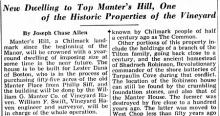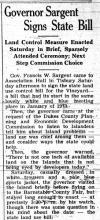A group of developers who want to build a golf course along the Edgartown Great Pond heard a team of scientists dismantle their environmental science last night, alongside an outpouring of statements from a striking array of Vineyard residents who urged the Martha’s Vineyard Commission in passionate tones to reject the golf course plan.
“We need to think about Martha’s Vineyard and why do we all live here?” said Tara Hickman.
“Trade a natural piece of heaven on earth for a manicured, hyper-fertilized artificial landscape? No thank you,” declared Liz Bradley.
“My credential is that I love Martha’s Vineyard. In the spirit of Rachel Carson, in the spirit of Henry Hough, we want the Vineyard in the future to have the spirituality that it does now,” said Tony Balis.
“We urge you to reject this proposal in the name of all these Island values,” said Jeffrey Agnoli.
The people who spoke out against the golf course plan hailed from all corners of the Island, including Aquinnah, Chilmark, West Tisbury, Vineyard Haven and Edgartown.
Their remarks came during a second night of public testimony on the proposal for an 18-hole golf course on 200 acres of land owned by the MacKenty and Bigelow families in Edgartown. The families have agreed to sell their land to Rosario and Barry Lattuca, a father and son team from Natick. The development group is called the Meeting House Golf Club. The project is pending before the Martha’s Vineyard Commission as a development of regional impact (DRI).
A public hearing on the plan opened on Jan. 28. An overflow crowd of some 200 people jammed the lower level of the Old Whaling Church in Edgartown for the second session, which went on for three and a half hours last night. The hearing will continue in a third session next Thursday night.
At the outset, project manager Kelly Cardoza gave a brief summary of the work that has gone on since the first hearing. Miss Cardoza said members of the project team had developed responses to questions raised by members of the commission staff, and she declared that all the questions had been answered to the staff’s satisfaction. Using an overhead projector, she also recapped the benefits of the project, stating flatly that the 18-hole golf course will have no impact on the pond, the ground water, plant life and wildlife on the property.
She said some questions had been raised about whether water use at the golf course will affect the private wells of neighboring property owners (the term for this effect is drawdown). “There will be no problem with neighboring wells, but if there is, we’ll fix it,” Miss Cardoza said.
She also recapped plans to contribute money to an array of community charities and said the group has worked out more details for the Great Pond Center, an independent research center that the group plans to set up to monitor the pond and the golf course. Miss Cardoza said the center will be governed by a nine-member board with five members to be chosen by community groups such as the MVC, “so they will have some credibility.”
The center director will be Arthur Gaines, a senior scientist at the Woods Hole Oceanographic Institution who has been hired as point man in the environmental team for the golf course developers, she said.
Ornithologist E. Vernon Laux gave a detailed presentation about plans to put up hundreds of bird houses for an array of nesting birds on the property, including bluebirds, chickadees and wood ducks.
The golf project’s environmental reports, most of which are based on computer-generated models, came under sharp fire from a team of experts hired by the Vineyard Conservation Society (VCS).
VCS executive director Brendan O’Neill reiterated the long-held position of his group that the MacKenty land is a poor choice for an 18-hole golf course.
“This is the wrong site,” he said.
Mark Nelson, a hydrogeologist with Horsley & Witten in Sandwich, said scientists working for the developers used extremely low standards when calculating how much nitrogen will leach into the pond and the ground water from fertilizers. Mr. Nelson said golf course projects on Cape Cod use a much higher standard. Using any reasonable standard, he said, the project as it is now proposed will significantly increase the nitrogen in the pond. Mr. Nelson also said the golf group experts have badly miscalculated the impact on the pond and ground water from pesticides because their assumptions about the layer of topsoil calls for far higher amounts of organic matter than actually exists in the sandy, gravelly soils near the Great Pond.
Mr. Nelson said the applicant’s statement of no negative impact sets an extraordinarily high standard. “They have really raised the bar, and what it says to those of you [on the commission] is if there are any negative impacts, then you must deny the project,” Mr. Nelson said.
The developers plan to tap a nitrogen-rich plume of ground water that is flowing from the Edgartown wastewater treatment plant toward the pond as a source for watering the golf course. Mr. Nelson said tapping the plume could be beneficial, but the source of nitrogen-rich water will only last for about 10 years, because the treatment plant has been upgraded and is no longer discharging high levels of nitrogen into the ground water.
Richard D. Klein, the director of a community and environmental defense group who has studied the effects of golf courses on aquatic life, used charts with bar graphs to show the effects of nitrogen and pesticides on the pond. The charts showed that conservation land and even residential housing would have a far lower impact on the pond.
The developers plan to use 4,000 to 5,000 pounds of nitrogen fertilizer and 1,200 pounds of pesticides each year on the golf course. By contrast, Mr. Nelson said, a local farmer who has been growing vegetables at the MacKenty property uses about nine pounds of pesticides each year.
Scientists for the golf course developers disputed the critique in testy tones at the end of the session and said they will return next week with a more detailed response.
All experts aside, many ordinary citizens were bluntly skeptical at the suggestion that the golf course will have no impact on the pond or the environment.
“Cutting hundreds of acres of trees is going to have no impact on wildlife or on the pond? Impossible. I just don’t believe it,” said William Marks, an Island resident who has worked for many years on water quality issues.
Mr. Marks warned the commission about synergisms, a phenomenon which occurs when chemicals combine with each other in the environment to create new and unknown compounds.
“Rachel Carson told us about this in her book Silent Spring — this applies now,” Mr. Marks said.
Cathy Fitzgerald, a member of the Chilmark conservation commission, also spoke out about the dangers of pesticides, noting that one of the chemicals listed by the developers was an active ingredient in the now infamous Agent Orange, used during the Vietnam War.
“The only thing this pond has to protect it is the Martha’s Vineyard Commission and the Island populace,” said Jay Guest.
Edgartown shellfish constable Paul Bagnall and conservation commission member Steve Ewing both pointed out that the golf course plan contravenes local regulations that strictly prohibit pesticide and fertilizer use within 300 feet of the pond. Five of the golf course holes are located within the pond zone affected by these regulations. The developers reportedly have said they will apply for waivers to the regulations, but last night they had no comment on the problem.
Concluded Mr. O’Neill: “We ask you not to allow one of the last undeveloped coastal ponds in the Northeast to become an experiment.”








Comments